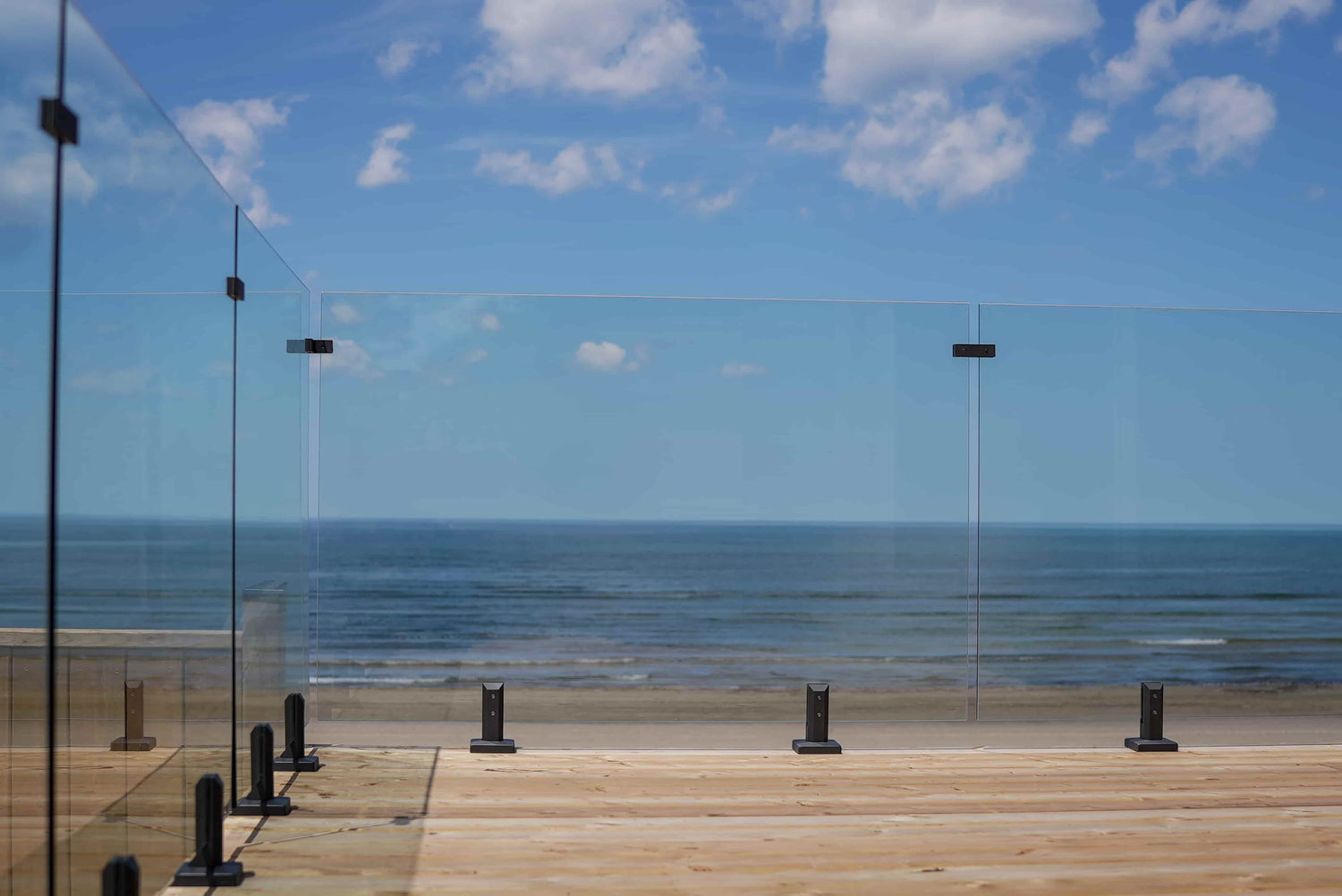Nova Scotia Building Code for Glass Railings

The Nova Scotia Building Code (NSBC) is a crucial tool in the construction industry within this province. It defines construction and safety regulations, including frameless glass railing installations.
It helps you get the best out of your patios, stairways, balconies, and decks while ensuring building safety. Therefore, ensure the design and installation of glass guardrails in your building strictly conform to this code.
You can successfully adhere to guard railing requirements if you know the guidelines that define design and installation. As such, this guide should help you achieve compliance whenever you decide to decorate your home or office with glass railing systems.
About the Nova Scotia Building Code
The Nova Scotia Building code was first created in the 20th century. Since then, this regulatory document has evolved to meet the challenges and requirements of the modern world.
In particular, the NSBC has considered significant advancements in technology. On the other hand, these advancements have led to drastic changes to building safety compliance guidelines to protect human lives.
For this reason, each code revision has included or removed provisions that provide minimum allowable safety without compromising functionality. The latest version of the Nova Scotia Building was revised on March 15, 2021, by the Minister of Municipal Affairs. It has been in use effective from October 1, 2022.
The NSBC is a separate regulation independent of the National Building Code of Canada (NBC). However, some of the provisions and safety requirements of these codes overlap.
Where Glass Railings Systems are Required
When installing a normal guardrail or a frameless glass railing, the NSBC requires you to have guardrail systems in specific locations. Patios, decks, stairs, and lofts must have guardrails if the platforms are more than 610 mm (24 inches) above the floor.
Similarly, areas within the following building types require glass guardrails that support users and prevent accidental falls.
- Residential Buildings: Decks, balconies, stairways, and other elevated platforms must have guardrails.
- Commercial Buildings: Elevated office buildings, public access areas, and retail spaces with staircases, balconies, and walkways may need glass railing systems.
- Institutional Buildings: All government buildings, hospitals, and schools with elevated platforms, including decks, ramps, and other access spaces, may also require glass railings.
To ensure adherence to glass railing requirements, you must also ensure guard rails do not have openings that allow a spherical object more than 100 mm (4 inches) in diameter to pass. This building safety compliance guideline is in place to prevent small children from passing through glass deck railings.
Detailed Glass Railing System Requirements
Glass guardrails, especially frameless glass railings, can transform your home into a modern and aesthetically pleasing environment ideal for spending time with family and hosting parties. You cannot achieve this look without following the Nova Scotia Building Code for glass railings.
The basic guardrail system requirements you must know are glass and railing specifications.
Glass Specifications

Various factors determine glass specifications, including glass type, thickness, standard, and impact resistance. Let us discuss these factors in more detail below.
Glass Type
You cannot use any glazing in the market for guard rails and glass railing systems. The Nova Scotia Building Code requires you to use tempered or laminated glasses, which are strong and possess several safety features.
Tempered glass is a glass type that is strengthened with heat. When it breaks, it usually disintegrates into tiny pieces, making it less likely to harm users.
On the other hand, laminated glass is made of various layers, preventing it from shattering when it breaks. Therefore, if you are looking for extra protection, you may use heat-treated laminated glass, which combines the advantages of tempered and laminated glazing.
To ensure building safety, you should never use any of these glasses if you see any crack or chip.
Thickness Specs
The glass panel used in all guardrails must be at least 12 mm (0.5 inches) thick in residential buildings. This requirement increases to 16 mm (0.6 inches) and more for commercial and industrial areas.
Your municipality may have special glazing thickness safety requirements. So, in addition to the Nova Scotia Building Code, check local compliance guidelines for more information.
Impact Resistance
Another crucial factor to consider when evaluating glass specification is impact resistance. Your installer must use thick, high-quality tempered or laminated glazing capable of withstanding a concentrated load of 200 lbs and a linear load of 50 lbs per linear foot.
Railing Height Specifications

Guardrail specifications for frameless glass railings primarily involve railing height requirements. Platforms like porches, verandas, and decks that exceed 610 mm (24 inches) in height must have guardrails.
Other railing system specifications are summarized below.
- A guardrail must be at least 914 mm (36 inches) This requirement applies to exterior and interior stairs with 6 and 2 risers, respectively.
- The glass railing system must be designed to prevent users from climbing. Therefore, it should have no opening or projection that allows users to elevate themselves above the guard.
- Once the distance between a porch, veranda, or deck exceeds 6 ft, its glass railings must be a minimum of 1067 mm (42 inches)
Height-related requirements not captured by the Nova Scotia Building must meet the National Building Code regulations.
Pool Fencing Requirements

If you plan to install a pool, you must pay close attention to glass guard safety regulations. In particular, you must learn about pool fencing compliance guidelines.
Below are enclosure building safety regulations to consider.
- An in-ground or above-ground pool containing water to a depth of 610 mm (24 inches) must have a fence.
- Fencing should be at least 1500 mm (59 inches) high above the ground level for in-ground and above-ground pools.
- There must be no objects or equipment at least 1200 mm (47 inches) away from the fence.
- The pool enclosure should have at least one gate equipped with self-latching and self-closing mechanisms.
- There must not be openings in the fence more than 100 mm (4 inches) in diameter.
- The enclosure should not facilitate climbing.
- Do not start constructing pool enclosures without a permit from your local government. Doing this can lead to unwanted sanctions.
Always work closely with inspectors to ensure you follow building safety compliance guidelines.
Inspection and Maintenance Tips
Having a sparkly-looking frameless glass railing does not mean your work is over. You are required to switch over to inspection and maintenance mode.
The following tips should help keep your glass deck railing in excellent condition. It should also limit the risk of accidents due to loose fittings.
- Regularly inspect the glass railing system to ensure there are no loose components or chips and cracks in the glass panels.
- Regularly cleaning the glass surface should help you maintain a clear appearance that simplifies inspection. You must avoid using harsh or abrasive cleaners that may damage glass panels or railing components.
- Consider applying anti-slip treatment to glass to improve user safety, especially if you live in a humid environment.
- Glass guardrails, especially frameless glass railings, should withstand changing weather conditions, including moisture, extreme temperatures, and wind. Therefore, consider applying a weather-resistant coating to the railing components, especially if you install an outdoor system.
- Apply UV protection to glass to reduce degradation and maintain the integrity of glass panels.
Conclusion
The Nova Scotia Building Code offers guidance for construction projects, including glass railing system design and installation. This code has been periodically reviewed to guide glass panel and glass railing requirements.
Furthermore, the NSBC together with the National Building Code, mandates strict safety regulations for pool enclosures. Finally, the inspection and safety tips presented can help keep your deck and other frameless glass railing systems in top condition.
Nova Scotia Building Code for Glass Railings FAQs
Does Nova Scotia have a building code?
Nova Scotia has a building code that came into effect on October 1, 2022. Together with by-laws in municipalities and the National Building Code, the Nova Scotia Building Code guides construction work across the entire province.
How high does a railing have to be in Nova Scotia?
The height of railing systems starts at 914 mm (36 inches) once a deck, balcony, or any other platform is elevated 610 mm (24 inches) above the floor. Platforms that exceed 6 ft high from the finished floor require 1067 mm (42 inches) high guardrails.
Are frameless glass railings safe for children?
Frameless glass railings are safe for children and can be used for any building. Building safety compliance guidelines in Nova Scotia ensure guardrails do not have openings wider than 100 mm (4 inches) in diameter. Also, the edges of glass panels are blunt and rarely injure users.
Let customers speak for us

Glass Railing Near You
Discover how The Glass Railing Store has been delivering exceptional service to our customers, thanks to our dedicated and knowledgeable team and their love our glass railing products.







